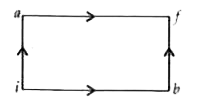આકૃતિમાં દર્શાવેલ પ્રક્રિયામાં એક પ્રણાલીને 1a2 માર્ગ પર લઈ જતાં 50 cal ઉષ્મા શોષીને 20 cal કાર્ય કરે છે. માર્ગ 1b2 માટે Q = 36 cal તો W શોધો.

56 cal
66 cal
16 cal
6 cal
The correct Answer is:D
Step by step video & image solution for આકૃતિમાં દર્શાવેલ પ્રક્રિયામાં એક પ્રણાલીને 1a_2 માર્ગ પર લઈ જતાં 50 cal ઉષ્મા શોષીને 20 cal કાર્ય કરે છે. માર્ગ 1b_2 માટે Q = 36 cal તો W શોધો. by Physics experts to help you in doubts & scoring excellent marks in Class 11 exams.
Updated on:21/07/2023Topper's Solved these Questions
- થર્મોડાયનેમિક્સ BOOK - PHOENIX PUBLICATIONCHAPTER - થર્મોડાયનેમિક્સ EXERCISE - Exercise
460 Videos
- તરલના યાંત્રિક ગુણધર્મો BOOK - PHOENIX PUBLICATIONCHAPTER - તરલના યાંત્રિક ગુણધર્મો EXERCISE - Exercise
269 Videos
- દોલનો અને તરંગોBOOK - PHOENIX PUBLICATIONCHAPTER - દોલનો અને તરંગોEXERCISE - Exercise
385 Videos
Similar Questions
બધી જ રીતે સમાન એવા બે ધાતુઓ ના સળિયાઓના છેડા વેલ્ડિંગ કરી આકૃતિ (1) માં દર્શાવ્યા પ્રમાણે જોડેલા છે તેમાંથી 20 cal ઉષ્મા પસાર થતા 4 min લાગે છે,હવે જો આ સળિયાઓને આકૃતિ (2) માં દર્શાવ્યા પ્રમાણે વેલ્ડિંગ કરી જોડવામાં આવે,તો આટલી ઉષ્મા ને પસાર થતા લાગતો સમય.....થાય.
 ,
,
View Solutionસામાન્ય પુખ્ત વ્યક્તિની શારીરની મહાધમનીમાંથી વહેતા - લોહીની સરેરાશ ઝડપ 0.33ms−1 હોય છે (મહાધમનીની ત્રિજ્યા 0.9 cm). મહાધમનીમાંથી લોહી 30 મિનીઓમાં જાય છે. જેમની દરેકની ત્રિજ્યા 0.5 cm છે, તો ધમનીમાંથી પસાર થતા લોહીની ઝકપ શોધો .
View Solutionએક સરળ આવર્તગતિ કરતા પદાર્થ માટે વેગ અને સ્થાનાંતર વચ્ચેનો સંબંધ 4v2=25–y2 છે ,તો સરળ આવર્તગતિ નો આવર્તકાળ શોધો.
View SolutionWhen a system is taken from state i to state f along the path iaf, it is found that Q=50 cal and W=20 cal . Along the path ibf Q=36cal . W along the path ibf is
View SolutionWhen a system is taken from state 1→2 along the path 1a2 it absorbs 50cal of heat and work done is 20cal. Along the path 1b2. Q=36cal. What is the work done along 1b2?

View SolutionWhen a system is taken from state i to state f alone the path iaf, it is found that Q=50 cal and W=20 cal. Along the path ibf, Q=36 cal (figure) (a) What is W along the path ibf ? (b) If W=-13 cal for the curved return path f i , what is Q for this path ? (c) Take U_(i)=10 cal. What is U_(f) ? (d) If U_(b)=22 cal, what is Q for the process in and for the process bf ?
View SolutionSolve : ΔH=10k cal mol−1,ΔS=20 cal deg−1mol−1andT=300k. Then ΔG=?
View SolutionFor a closed system, determine the change in internal energy (DeltaU) when (a) q cal of heat is absorbed by the system and w cal of work is performed on the system (b) q cal of heat is absorbed by the system and w cal of work is performed by the system (c) q cal of heat is evolved by the system and w cal of work is performed on the system (d) heat is not absorbed or evolved by the system, but w cal of work is performed by the system.
View Solution50 g of ice at 0^@C is mixed with 50 g of water at 80^@C . The final temperature of the mixture is (latent heat of fusion of ice =80 cal //g , s_(w) = 1 cal //g ^@C)
View SolutionWhen a system is taken from state I to state f along the path iaf, it is found that Q = 50 cal and W = 20 cal. Along the path ibf, Q = 36 cal. W along the path ibf is

View SolutionAmount of energy come from fat:
1. 930 cal
2. 1000 cal
3. 900 cal
4. 400 cal
View SolutionHeat of formation of CO2,H2O&CH4are−100cal,−50cal&−70cal. Find heat of combustion of CH4.
View SolutionIn the diagram shown Qiaf=80 cal and Wiaf=50cal. If W = - 30 cal for the curved path fi,value of Q for path fi, will be

View SolutionWhen a system is taken from state i to state f along the path iaf, it is found that Q=50calandW=20cal. Along the path ibf Q=36cal. W along the path ibf is

View SolutionWhen a system is taken from state i to state f along the path iaf, it is found that Q=50 cal and W=20 cal . Along the path ibf Q=36cal . W along the path ibf is
View Solution50 g of ice at 0∘C is mixed with 50 g of water at 80∘C . The final temperature of the mixture is (latent heat of fusion of ice =80cal/g,sw=1cal/g∘C)
View Solution
